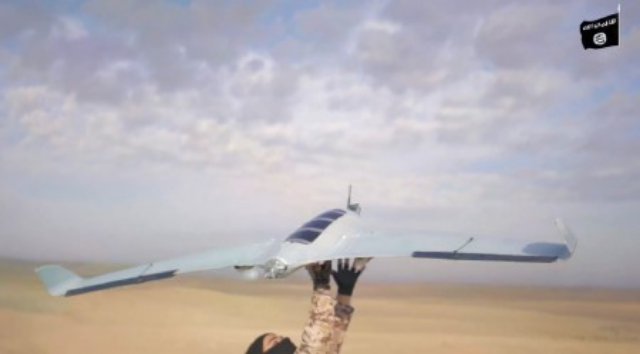
Screen capture from Islamic State video
Much has been made of the Islamic State drone threat ever since the group killed two Kurdish soldiers in October 2016 with a bomb hidden within one of its drones that Kurdish forces downed in Iraq.1 The Islamic State was able to achieve this feat through an act of deception, as the two Kurdish soldiers were killed by the bomb after they had taken the drone back to their base to inspect it.
Since this type of attack had not been conducted before, the drone was an unassuming place for the Islamic State to hide an improvised explosive device. But that trick only works occasionally, and it likely has a limited shelf life.
Creativity and innovation, however, don’t appear to be problems for the Islamic State. Several days ago, on January 24, 2017, the group’s media office for Ninawa province released a video entitled “The Knights of the Dawawin,” which highlighted a new Islamic State drone capability: dropping small bomb-like munitions on its enemies from the air.2 The capability displayed was not a one-off achievement as in scene after scene the video shows the group dropping small bombs from remotely controlled drones and doing so with some level of relative accuracy. This included the Islamic State being able to successfully drop munitions onto crowds and to hit stationary vehicles and tanks while its drone loitered and filmed the incidents.
Besides the surprise factor observed from those being targeted by the Islamic State’s drones, the video also showed that the group’s new capability packed enough punch to wound and/or kill those near where the munition landed. And on January 30, the Wilayat al-Furat media office released a video entitled “Roar of the Lions” in which the Islamic State featured its military operations in the Anbar Province of Iraq. At the end of the video, the group showed a brief teaser for its next release, which contained a video clip of the drone bomb drop capability (this time with what appeared to be a round grenade) being used in Anbar.
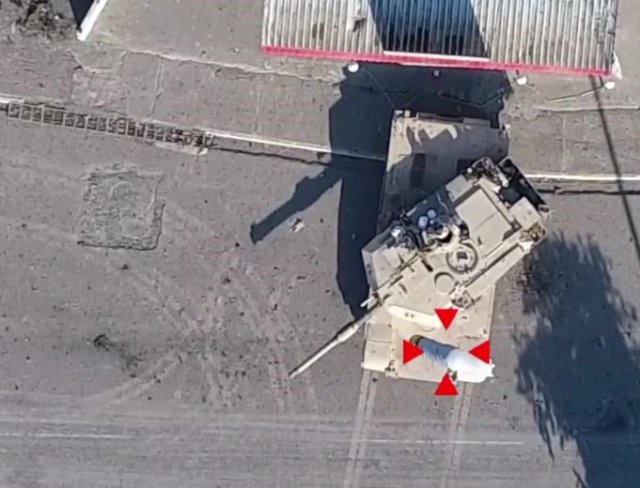
Screen capture from Islamic State video showing a drone munition drop targeting a tank
Despite these achievements, it is also important to remember that the videos released by the Islamic State are edited pieces of propaganda, which likely have been carefully crafted to make the group—and its capabilities—look impressive. What isn’t being shown are all of the times U.S. and Iraqi forces have downed the Islamic State’s quad-copters3 or instances when the Islamic State’s new drone bomb drop tool were less accurate.
The recent discovery of a small batch of internal Islamic State documents, which were recovered in Iraq and provided to the Combating Terrorism Center (CTC), provides an inside look into how the group has sought to cobble together, develop, and enhance its drone capabilities as well as manage its drone program. The paragraphs below provide a description of the documents and an overview of their significance in light of what is already known about the Islamic State’s use of drones.
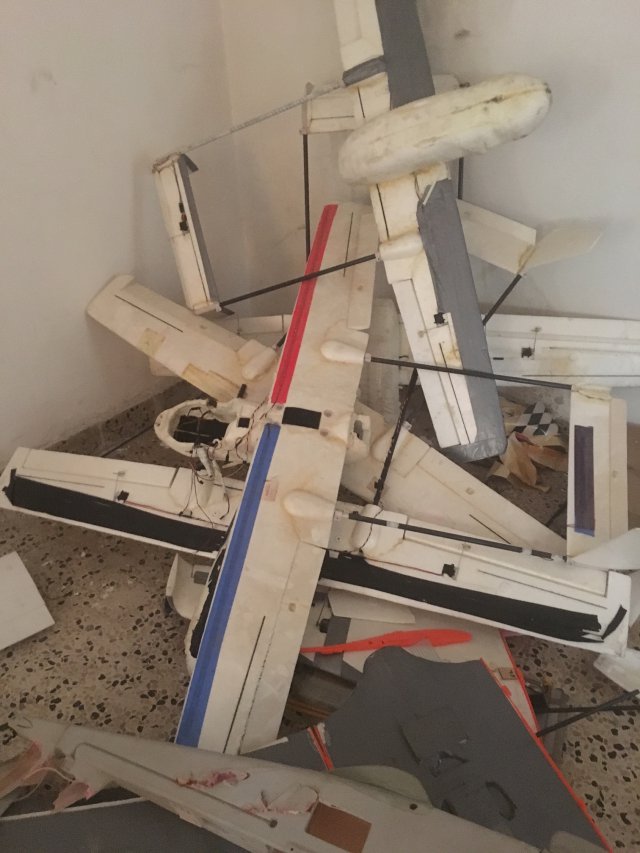
Drones at Islamic State drone facility in Mosul, Iraq (Vera Mironova)
The Documents: Background and Caveats
The documents reviewed for this analysis were provided to the CTC by Vera Mironova, a research fellow at the Belfer Center at Harvard University. Ms. Mironova personally obtained hard copies of the documents while she was conducting field research in Iraq, embedded with an Iraqi military unit. The documents were discovered in a facility formerly under the control of the Islamic State located in the Muhandeseen neighborhood of Mosul, near Mosul University.
While confirming authenticity of these types of documents is always a challenge, the authors believe they are real given the location and circumstances of their acquisition, the nature of the documents, and the CTC’s experience working with a wide array of captured battlefield material. All of the documents appear to be from the 2015 time period, and the collection includes a mix of official Islamic State forms and handwritten notes. The 21 documents themselves can be broken down into four main categories: drone use reports (2), equipment lists/purchase requests (11), receipts or purchase forms (6), and permission documents (2). Given the small number of documents, it is not clear how representative this collection is of the full range of internal Islamic State documentation about the group’s drone program. It is very likely that these documents represent only a very small fraction of internal Islamic State material on this topic. Researchers should read the analysis below with these particular caveats in mind.
Key Takeaways
There are a number of important takeaways that can be gleaned from the documents. They include:
The Islamic State is Bureaucratic about its Drones, Too
The discovery and capture of internal documents produced by the Islamic State and its predecessor organizations have demonstrated that the group is fairly detail-oriented and bureaucratic when it comes to its operations. Indeed, analyses of previous caches of Islamic State material related to its foreign fighters, media activity, and weapons development have all pointed to an organization that has sought to institutionalize the capture of data through the use of administrative documents and related procedures.4 The Islamic State’s drone activity appears to be no exception, as two of the forms found within the collection were standardized drone use reports that had been filled out by Islamic State drone operators after they had completed their missions. According to this set of documents, the Islamic State drone unit conducting these missions falls underneath the Al-Bara’ bin Malik Brigade, as both forms—filled out based on incidents that occurred in different provinces—carried this header. This Brigade is subordinate to the Islamic State’s Committee of Military Manufacturing and Development. Other documents in the collection were produced by the Aviation Sector of this committee.
The standardized four-page form that Islamic State drone operators needed to fill out contained four main sections. On the first page, drone operators were asked to provide the following details about their mission: type of mission (out of six pre-set options that they could select, two indicated weaponized drone missions: “Bombing” and “Explosive Plane”), group members who were involved, location of the mission, and waypoint coordinates for the flight. (The two drone use forms in the collection were both for “training” missions.)
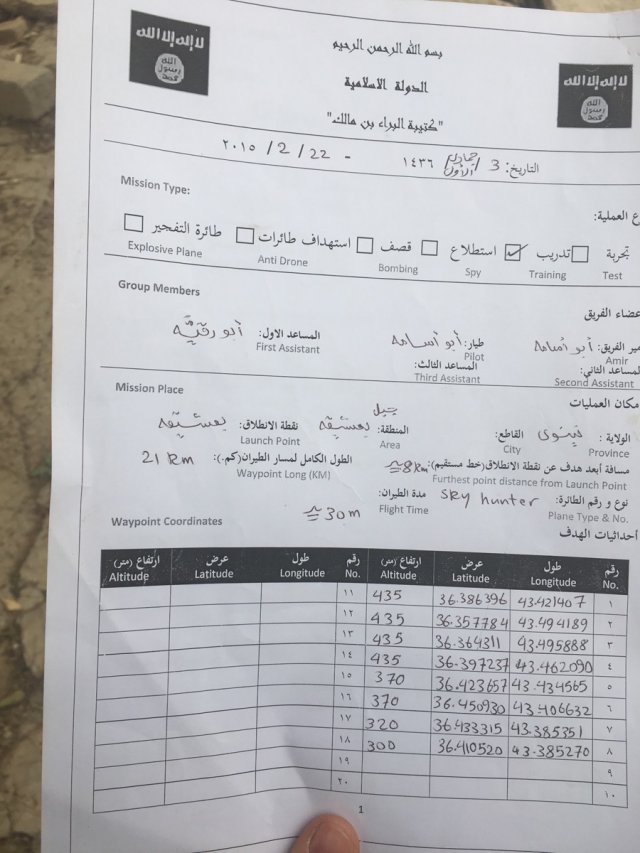
First page of Islamic State drone use report form
The second page of the form consisted of a checklist that appears to have been designed to help the drone operators conduct pre- and/or post-mission confirmation of the functionality of their systems and equipment (to include “Bomb Ignition sys” and “Bomb ignitor RC”). The third page is a checklist of tools and devices in the operator’s “Tool Case.” The last page of the form asked the operators to note whether their mission had succeeded or failed. It also provided space for the operators to write notes, perhaps to document lessons learned from failed missions or interesting events that occurred during successful ones.
One of the documents suggests that the drone program was given a certain level of priority. A document signed by the wali of Wilayat al-Jazira requested on October 4, 2015, that the Committee of Military Manufacturing and Development “provide the brothers in the Aviation Brigade of our wilaya with whatever they need from you.”
The Islamic State Has an Institutionalized Drone Program, Not a Series of One-Off Incidents, and Planned for Weaponization as Early as 2015
The documents in the collection confirm and add color to findings the CTC made in October 2016 about the nature of the Islamic State’s drone activity.5 At that time, the CTC identified the Islamic State as being one of four terrorist organizations to have a bona fide drone program.6 Public records indicate the Islamic State’s interest in drones dates back to at least 2013,7 and a number of documents in the collection demonstrate 1) how the Islamic State had a formal, institutionalized, and resourced drone unit as early as 2015, if not before; 2) how this same unit was collecting paperwork from different Iraqi governorates (e.g. Ninevah and Saladin), demonstrating broader geographic management of Islamic State drone activity; and 3) that in 2015 the Islamic State already had plans to use its drones as attack weapons, based on the presence of weapons-related checkboxes on the drone use report documents. Supply lists in the collection also confirm how the Islamic State has been acquiring hardware and other tools to modify and enhance the performance of commercially available drones and to build its own based on existing airframes.8 None of these points are tremendously surprising as the level of focus—and obsession with details and standardization—mirrors the approach the Islamic State has taken with other programs, like the development of rockets and mortars.9
Acquisition and Purchase Lists Reveal that Islamic State Drones are Not That Sophisticated, but Those Same Lists Also Show How the Group is Resourceful, DIY-Minded, and Solution-Seeking
A preliminary review of the equipment and purchase list items, which all appear to be readily available online, tells a mixed story. On one hand, the lists show the Islamic State’s efforts to acquire predictable items like a GoPro camera, memory cards, GPS units, digital video recorders, and extra propeller blades. Yet, on the other hand, the lists also speak to the group’s efforts to secure, modify, and enhance the range and performance of its drones, whether commercially procured or otherwise. For example, to protect the transmission of their drone video feeds, members of the group wanted to acquire encrypted video transmitters and receivers. A long-range radio control relay system produced by Foxtech was also included on a number of acquisition lists (so the group could extend the range of its drones), as were various types of servo motors.

Islamic State Purchase/Receipt Form
While servo motors can be used for a variety of drone-related tasks, they can also be used to facilitate a release mechanism like the release of a munition from an Islamic State drone,10 a tactic with which the group appears to have become quite proficient.11 The inclusion of these types of items demonstrates how even though the drone material being requested by the Islamic State is something that a “sophisticated high schooler could put together” and develop plans for, some of these items can be used for more sinister purposes that can maim or kill.12
The documents do not reveal how the Islamic State actually acquires the material found on the lists. Given the specific price information provided on forms that appear to be either receipts or purchase forms, it is possible that the Islamic State is acquiring some of this equipment directly online—likely through third parties in countries outside the region, to potentially include popular online retailers.
Who Does What: Is There a Bangladeshi Foreign Fighter and Islamic State Drone Program Connection?
Although it is difficult to judge based on the small number of documents in the collection, the files suggest that fighters from certain countries and/or backgrounds could be playing a disproportionate role in the Islamic State’s drone operations. For example, while fighters from various countries like Turkey and Saudi Arabia show up in the Islamic State’s drone documents, the only foreign country with two fighters represented in the collection was Bangladesh. This data point is odd, and noteworthy, as the CTC’s analysis of over 4,500 Islamic State foreign fighter records found only three fighters from that country.13 The potentially disproportionate level of Bangladeshis in the Islamic State’s drone unit could be due to the skills of those individuals, dynamics related to their own personal networks (i.e. they are friends or know similar people), or the result of a particular placement strategy used by the Islamic State to staff select units. It could also be coincidental.
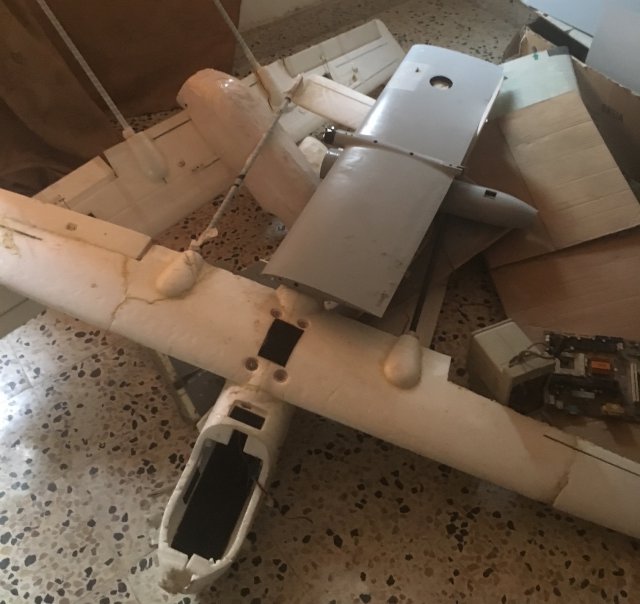
Drones at Islamic State drone facility in Mosul, Iraq (Vera Mironova)
Future Islamic State Drone Use
The documents provide few insights into the Islamic State’s future drone plans. In the short-term, we should expect the Islamic State to refine its drone bomb-drop capability. It is likely that the Islamic State’s use of this tactic will not only become more frequent, but more lethal as well.
One surprising omission from the acquisition lists, which could be telling, were requests for quad-copter-style drones. When requests for drones were featured in the documents, they were for fixed-wing airplane bodies. While fixed-wing drones cannot hover and stay in place, they offer certain advantages such as being able to fly much farther from their controller than quad-copter variants. Indeed, one of the Islamic State drone use reports found in the collection lists the “Farthest Point Distance from Launch Point” of a fixed-wing SkyHunter drone as approximately eight kilometers.
This, and the showcasing of an X8 Skywalker drone (one of the fixed-wing bodies that was requested by the Islamic State in the documents) in its recent video, suggests that the Islamic State might be eyeing the use of fixed-wing drone platforms for other operational purposes, including using them to penetrate facilities and/or conduct longer-range surveillance or attack missions. The discovery of an abandoned Islamic State drone workshop in Ramadi in February 2016 by Conflict Armament Research field investigators, which was being used by the terror group to produce homemade fixed-wing drones, lends some additional credence to this line of thinking.14 So too does the discovery of a disassembled man-portable air defense system, including the missile’s steering unit and warhead section, at that same facility.15 (The Islamic State’s experimentation with and use of chemicals as weapons, and its interest in producing biological agents, may also provide additional pathways for future, weaponized drone use.16)
Islamic State supporters on online forums have dropped similar hints that this might be what the group has in store. For example, in July 2016, one of the active members of al-Minbar al-I`lami al-Jihadi forums named “al-Fajr” claimed that an Islamic State member had told him that the group was developing “an attack drone that can carry rockets and explosive materials.”17 This past December, that same forum member posted a similar message: “Your brothers have developed airplanes bigger than those they had before, and they’re developing matching rockets that can be carried by these airplanes and controlled from the ground … also, information was leaked to me that an engineer who used to work in airplanes manufacturing in one of the countries advanced in that field has joined the Islamic State.”18
Even if al-Fajr’s claims prove false, the Islamic State’s latest videos and these newly obtained documents demonstrate that the Islamic State’s drone program should be taken seriously.
Don Rassler is Director of Strategic Initiatives at the Combating Terrorism Center at the U.S. Military Academy at West Point. His research is focused on terrorist innovation and the changing dynamics of Afghanistan’s and Pakistan’s militant landscapes.
Muhammad al-`Ubaydi is a research associate at the Combating Terrorism Center at the U.S. Military Academy at West Point and monitors Arabic jihadist websites.
Vera Mironova is an international security fellow at the Harvard Kennedy School’s Belfer Center.
The views presented are those of the authors and do not necessarily represent the views of the Department of the Army, Department of Defense, or U.S. Government.
Substantive Notes & Citations
[1] Michael S. Schmidt and Eric Schmitt, “Pentagon Confronts a New Threat From ISIS: Exploding Drones,” New York Times, October 11, 2016.
[2] The United States military reported on the Islamic State having this capability, and using quadcopter drones to drop munitions on Iraqi forces in Mosul, on January 12. See “ISIS Using Hobby Drones to Bomb Forces in Mosul,” AFP, January 12, 2017. As reported by Mitch Utterback, these bomb-like munitions could be 40mm rifle grenades. For background, see Mitch Utterback, “How ISIS is Turning Commercial Drones into Weapons in the Battle for Mosul,” Fox News, January 25, 2017.
[3] Utterback.
[4] For background, see Brian Dodwell, Daniel Milton, and Don Rassler, The Caliphates Global Workforce: An Inside Look at the Islamic State’s Foreign Fighter Paper Trail (West Point, NY: Combating Terrorism Center, 2016); Daniel Milton, Communication Breakdown: Unraveling the Islamic State’s Media Efforts (West Point, NY: Combating Terrorism Center, 2016); and Standardization and Quality Control in Islamic State’s Military Production (London: Conflict Armament Research, 2016).
[5] For background, see Don Rassler, Remotely Piloted Innovation: Terrorism, Drones, and Supportive Technology, (West Point, NY: Combating Terrorism Center, 2016).
[6] The other three organizations were Hezbollah, Hamas, and Jabhat Fateh al-Sham. For background, see Rassler, pp. 25-39.
[7] Ibid., pp. 34-35.
[8] For background on the Islamic State’s efforts to manufacture drones, see Frontline Perspective: Islamic State’s Weaponised Drones (London: Conflict Armament Research, 2016).
[9] For background, see Standardization and Quality Control in Islamic State’s Military Production.
[10] The authors would like to thank Timothy Reuter, Vice President of the Association for Unmanned Vehicle Systems International Silicon Valley Chapter or AUVSI – SVC, for this point.
[11] The Knights of the Dawawin, Wilayat Ninawa Media Office, January 24, 2017. For more details about the Islamic State’s use of drones to drop munitions and for photos of captured devices, see Utterback.
[12] Author interview, Timothy Reuter, January 25, 2017.
[13] Other data points indicate that there is a Bangladeshi contingent of fighters who have joined the Islamic State and that the group has been actively targeting Bangladeshi citizens for recruitment. It is possible that the records for Bangladeshi foreign fighters were stored elsewhere or that these recruits arrived at a later date and their data is not reflected in the Islamic State personnel files held by CTC. For background on the dynamics of militancy in Bangladesh and the flow of fighters from that country to Syria and Iraq, see Animesh Roul, “How Bangladesh Became Fertile Ground for Al-Qa`ida and the Islamic State,” CTC Sentinel 9:5 (2016).
[14] Frontline Perspective: Islamic State’s Weaponised Drones.
[15] Ibid., p. 2.
[16] Harald Doornbos and Jenan Moussa, “Found: The Islamic State’s Terror Laptop of Doom,” Foreign Policy, August 28, 2014; Stephen Hummel, “The Islamic State and WMD: Assessing the Future Threat,” CTC Sentinel 9:1 (2016); Peter Bergen, “Al-Qaeda’s Track Record with Chemical Weapons,” CNN, May 7, 2013; Rassler, pp. 34-35.
[17] Post by “al-Fajr,” al-Minbar al-I`lami al-Jihadi forum, July 30, 2016.
[18] Post by “al-Fajr,” al-Minbar al-I`lami al-Jihadi forum, December 7, 2016.
